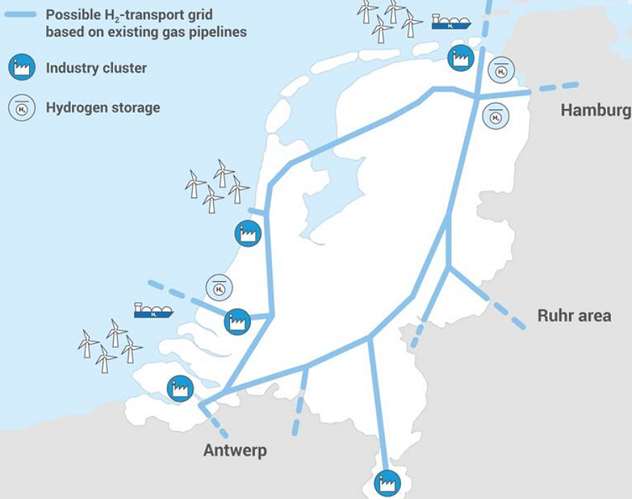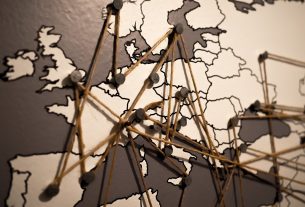The Netherlands – Budget Day 2021 has brought the Dutch clean hydrogen ambition a small step closer.
On Budget Day, the Dutch ruling coalition presented its plans for the coming Parliamentary year. They labelled climate change as one of the key issues that needs to be addressed with priority, and underpinned this message with a EUR 6.8bn support package. Part of that package will be used to fund the hydrogen ambition, which should help to decarbonize the energy system.
0.5 gigawatts of electrolyser capacity will be achieved by 2025, and 3 to 4 gigawatts by 2030 are the goals set forth in the Netherlands’ hydrogen strategy, which was released in 2010. All of these green hydrogen production plants will be linked to a hydrogen infrastructure in the future for the transportation of clean hydrogen. In order to speed up the development of green hydrogen, the strategy also combines green hydrogen production with offshore wind tenders.
Green light for the nation’s hydrogen infrastructure
One of the budget’s specific measures is the creation of a national hydrogen network, often known as a hydrogen backbone. The current natural gas grid will be upgraded to transport hydrogen for the great majority of this backbone’s (85%). New pipes will only make up around 15% of the system. There is a requirement for Gasunie, the country’s present natural gas transmission system operator, to upgrade and develop an infrastructure connecting five major industrial clusters in the Netherlands’ north, south and southwest with hydrogen production sites, ports and storage centers. There will also be cross-border linkages in the final system. For upgrading and building new pipelines, Gasunie anticipates total costs at EUR 1.5 billion. The government has pledged to help with EUR 750 million.
An additional 10 GW of offshore wind power
Wind farm zones with a combined capacity of 11.5 GW were penciled in for realization by 2030 in the Dutch government’s current Offshore Wind Energy Roadmap issued in 2018. The Dutch government acknowledged in its climate plans unveiled on Budget Day that additional offshore wind power is required to satisfy the country’s 2030 GHG emission reduction goals. Considering the Dutch hydrogen strategy, which calls for an extra 4 to 6 GW of added wind capacity by 2030 in order to generate enough wind energy for 3 to 4 GW of electrolyser capacity, this need becomes even more clear. This means that the Dutch offshore wind capacity will be 21.5 GW by 2030, as announced by the government on Budget Day. This is an increase of 10 GW.
No additional support for green hydrogen
Green hydrogen production needs EUR 6 billion to 7 billion in subsidies to scale up, according to government estimates. However, there were no new specific subsidies revealed on Budget Day.
The National Growth Fund allocated EUR 73 million to green hydrogen projects earlier this year and reserved another EUR 265 million. For special operational financial support for initiatives, another EUR 252 million was reserved. This totals EUR 590 million in specifically designated hydrogen cash support. In the eyes of the Dutch government, this is a far cry from what is required to get large-scale green hydrogen projects started. With a target of 3 to 4 gigawatts of hydrogen production capacity, this subsidy works out to about EUR 150 million to EUR 200 million per GW. It’s unclear if this will be enough to fulfill the Netherlands’ hydrogen ambitions, given how small the country is in comparison to the rest of the EU.
Hydrogen subsidy scheme in the Netherlands vs. other EU member states
Currently, only seven EU member states have made public their hydrogen 2030 goals. These seven countries are Germany, France, Italy, Spain, Portugal, Poland, and the Netherlands. The larger countries, of course, have loftier goals. However, in terms of capacity, France, not Germany, has the most ambitious plans.
Figure 3 shows the dedicated hydrogen subsidies in Germany, which are the most robust from a financial standpoint. Germany leads ahead from the rest in terms of overall dedicated subsidies as well as dedicated subsidies provided per gigawatt-hour of capacity. Despite its lofty stated goal, the Dutch government has failed to back up its plans with substantial devoted financial resources. In contrast, compared to other EU Member States, the specific subsidies provided by the Netherlands are feeble.
The Dutch government emphasized the importance of combating climate change on Budget Day 2021, when it announced a EUR 6.7 billion climate package. The government has identified green hydrogen as a crucial approach to reducing GHG emissions. The Netherlands developed its hydrogen plan last year to get a head start in growing this industry. Budget Day 2021 didn’t deliver the anticipated financial measures, in spite of the strategy’s lofty aims being backed by modest subsidies. The hydrogen industry in the Netherlands will have a harder time staying ahead of the curve as a result of this.




